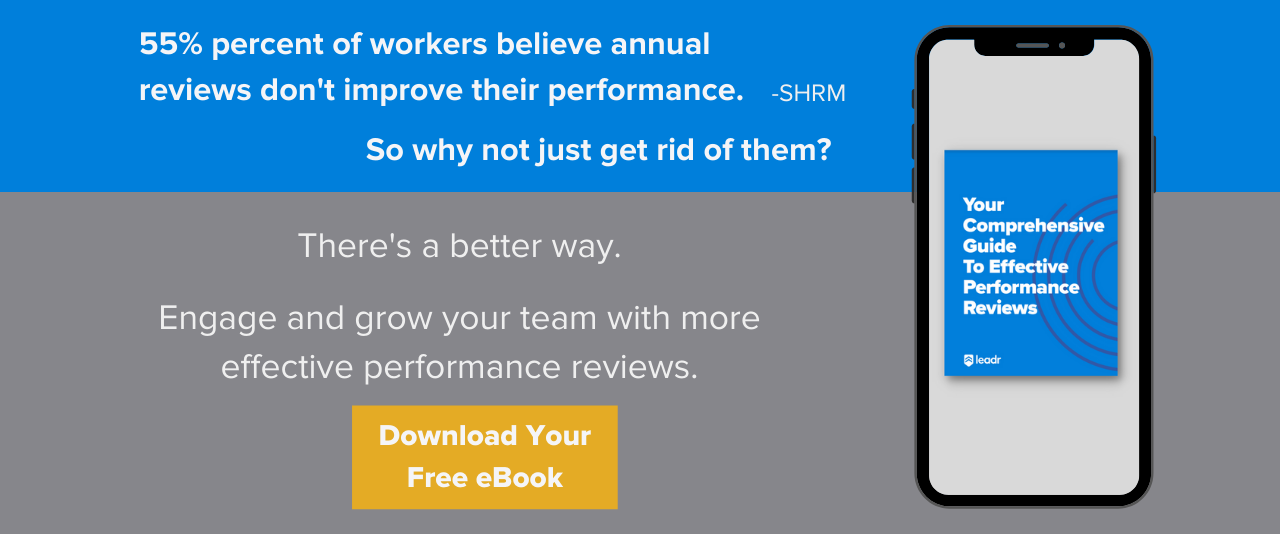Beyond Trendy Perks: What Employees Really Want for a Rewarding Workplace Experience
Today’s employees care more than ever about their employee experience.
Engaging and retaining your staff is becoming increasingly more difficult as organizations go above and beyond to provide a rewarding and healthy workplace experience.
But employees aren’t looking for the trendy perks that you might think. According to Gallup’s 2023 State of the Global Workplace, People who are disengaged (77% of global employees), are looking for things like:
- More recognition for their work.
- More communication from the leaders.
- Clear goals and stronger guidance.
- More opportunities to utilize their personal strengths.
- And more respect overall.
Let’s look into two practices you can implement that address each of these wish-list items: staff reviews and employee recognition.
Reviews and recognition are critical components of building a positive workplace culture. They help to promote employee satisfaction, motivation, and loyalty, which, in turn, can lead to increased productivity and improved job performance. By recognizing team members for their hard work and accomplishments, and having intentional conversations around their goals, you can create a culture of appreciation, which can help your employees feel more engaged and invested in their work.
Let’s explore the importance of these two practices.
What are Performance Reviews?
Employee reviews, also known as performance reviews or evaluations, are meetings between managers and employees to discuss job performance, accomplishments, goals, and areas for improvement. Reviews typically occur annually or bi-annually to provide feedback to the employee on their previous work and set goals for the future. They also create an opportunity for open communication between employees and management, which is key to building trust and respect.
In a post-COVID world, many organizations see performance reviews as a thing of the past. But in reality, having intentional check-ins are now more crucial than ever before, given the rise of remote work, employee expectations for an exceptional experience, and the need for meaningful feedback. More on that here.
Why Conduct Performance Reviews?
Employee reviews serve several important purposes:
1. Improving Performance
Reviews provide an intentional opportunity for managers to give feedback and set expectations for employees. When your team members understand the goals and what is expected of them, their performance and productivity will increase. In fact, Harvard Business Review found that 92% of people believe that constructive criticism is effective at improving performance.
2. Career Development
When you consider that 69% of employees feel that they are not living up to their potential at work, the need for routine feedback that spur career development is obvious. Reviews help employees identify areas where they can improve their skills and knowledge. This feedback can help them to set goals that will guide their career development.
3. Employee Engagement
A survey by Gallup found that businesses that provide strengths-based feedback had a turnover rate that was 14.9% lower than those who provided no feedback. When employees receive regular feedback and feel that their contributions are valued, they are more engaged in their work and more likely to stay with their employer.4. Accountability
91% of employees believe that accountability is a top leadership need. Reviews provide a formal record of an employee’s performance, which can be used for accountability purposes, such as promotions, pay raises, and disciplinary actions. It’s a time for leaders and employees to align on what it looks like for each employee to win in their role.
Best Practices for Effective Performance Reviews
So performance reviews can be helpful, but what does an effective review conversation look like?
1. Establish Clear Expectations and Goals
Before conducting a review, it’s important for everyone to be on the same page. This means outlining the job expectations, metrics for evaluation, and the company’s overall objectives and values. Without this context, employees may be unclear about what they’re working towards and what they should be prepared to discuss in the review.
2. Schedule Regular Check-Ins
Feedback and guidance that are provided once a year are much less effective than regular check-ins. While reviews are critical to recap and realign on expectations and performance, the real magic happens throughout the year in ongoing 1:1 conversations about performance and development.
3. Provide Specific Feedback
During reviews, it is important to provide specific feedback to team members, with concrete examples of what they’re doing well and where they can improve. Vague feedback like, “You’re doing a great job!” or “You need to work on your communication skills” isn’t helpful. Instead, provide specific feedback using recent examples that employees can act on.
4. Listen to Employees’ Concerns and Suggestions
Feedback is a two-way street. During reviews, it is essential to listen to employees’ concerns and suggestions. By actively listening to what your team members have to say, you can identify issues before they become bigger problems and show that you value the input of your team.
What is Employee Recognition?
Employee recognition is the opportunity for you to give your team members a pat on the back for their hard work and accomplishments. This could take the form of a shoutout in a meeting, a thank you note, or a coffee or lunch celebration. These simple gestures of recognition make your employees feel good about their work and motivate them to continue doing their best.
Why is Employee Recognition Important for Workplace Culture?
Feeling appreciated and valued is a huge motivator. In fact, a study by the Workhuman Analytics and Research Institute found that employees who feel valued at work are 60% more likely to stay with their current employer. When hard work is recognized, it boosts morale and gives a sense of accomplishment. Recognizing employees for their contributions fosters a culture of appreciation and respect. Let’s take a closer look at the benefits of employee recognition:
1. Improve Employee Engagement
A study by Glassdoor found that more than 80% of employees say they’re motivated to work harder when their boss shows appreciation for their work. Team members who feel recognized and appreciated are more likely to be engaged and productive at work. By recognizing their hard work and contributions, you can motivate employees and create a positive work environment.
2. Reduce Turnover Rates
Employees who receive recognition are more likely to stay with their current employer. In a study conducted by Globoforce, employees who receive recognition are 5 times more likely to feel valued and 7 times more likely to stay with their current employer.
3. Boost Employee Morale
Taking the time to recognize the accomplishments of your team members can go a long way in boosting morale. Simple gestures like saying “thank you” or offering public praise can make employees feel valued and appreciated. Who doesn’t enjoy a little well-deserved praise?
4. Encourage Teamwork and Collaboration
When your teams feel appreciated, they’re more likely to work together and support each other’s successes. A study by Gallup found that 66% of those on adequately praised teams trusted their colleagues, compared to 26% of those who didn’t receive team-based recognition.
Best Practices for Effective Employee Recognition
1. Make Recognition Timely and Specific
Your recognition and appreciation will be more meaningful to your team members when you provide it in a timely and specific manner. Rather than waiting for the annual review or project milestones, make recognition a regular part of your workplace culture. Recognize employees for specific achievements, such as completing a project on time or going above and beyond to help a colleague.
2. Make Recognition Public
Public recognition can go a long way in boosting employee morale and creating a positive work environment. Consider implementing a recognition program that publicly acknowledges employees for their hard work and contributions. This can be done through social media posts, company-wide emails, or public meetings.
3. Make Recognition Personal
Personalized recognition can make your team members feel even more valued and appreciated. Take the time to understand each employee’s unique interests and preferences, and tailor recognition to their individual needs. This can be as simple as offering a gift card to their favorite restaurant or giving them time off to pursue a hobby.
4. Encourage Peer-to-Peer Recognition
As valuable as your recognition is, it is equally important to create space for colleagues to celebrate each other. Encourage employees to recognize each other for their hard work and contributions. This can be done through a recognition platform or even a simple thank-you note.
Get more ideas for building a culture of recognition here.

Creating a healthy work environment is not only good for your team members, it’s also good for business. When employees feel supported, appreciated, and respected, they’re more engaged, productive, and motivated. Reviews and employee recognition are essential components of a healthy and positive work environment. By implementing effective practices for reviews and employee recognition, you can create a workplace culture that values and appreciates your team members.
Leadr’s people development software makes it easy to manage performance reviews, employee recognition, and more in one platform. Leadr empowers your team by providing a space for continuous communication and feedback, allowing you to recognize employees for their hard work and accomplishments. With Leadr, you can also stay on top of your team’s progress and development through customizable review templates and goal-setting features. Invest in your team’s success and try Leadr for yourself.
Check out a quick product overview here to see what Leadr could look like within your organization.
Share this
You May Also Like
These Related Stories

Your ultimate guide to solving for employee engagement and retention

Your Guide to Conducting Effective Exit Interviews: Questions, Best Practices, and Next Steps







No Comments Yet
Let us know what you think